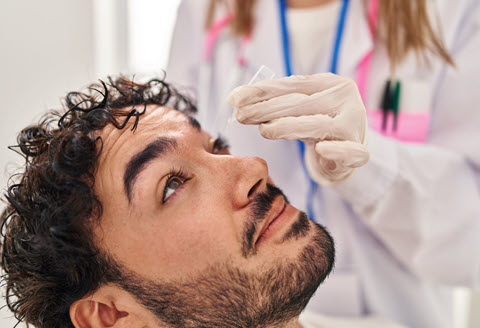Understand DED coding nuances to safeguard your practice’s reimbursement.
Nearly half of all U.S. adults experience signs and symptoms of dry eye disease (DED), and roughly a third of patients in eye care clinics present with complaints related to dry eyes. Consequently, there is a lot at stake for optometric and ophthalmic practices when coding and billing for DED.
Since there are several treatment options, including punctal occlusion, on the table, it’s critical to keep track of your CPT® and ICD-10 coding to give the payer a complete clinical picture of your patient’s condition and what you’ve done to address their dry eyes. So, keep reading.

Get to Know the Condition
DED is a common condition that occurs when a person doesn’t have enough quality tears to lubricate and nourish the eye. The volume of tears themselves may be inadequate, or the tears may be poor quality. This tear instability leads to inflammation and damage to the eye’s surface.
Watch for: The patient may complain of redness, stinging or scratchiness, irritation, light sensitivity, or blurred or fatigued vision, among many other signs and symptoms.
There are several ICD-10 codes that describe DED, but the most common ones are:
A note in ICD-10 specifies that you should use the H04.12- codes when your provider mentions “tear film insufficiency NOS” in the documentation. Keratoconjunctivitis sicca refers to chronic, bilateral desiccation of the conjunctiva and cornea caused by too little tear production or accelerated tear evaporation.
Other diagnoses you may see include:
Tip: Base your ICD-10 code on the clinical findings, not the patient’s complaint. For example, if the patient complains of a foreign-body sensation, and you see documentation of diffuse punctate staining, punctate keratopathy, epithelial defects, sterile corneal ulcers, corneal vascularization, or corneal scarring in both eyes, then you may want to use H16.223 to report the dry eye diagnosis. But if a tear volume test reveals low tear volume, H04.123 may be the appropriate choice.
Plug Away With Proper Procedure Coding
The insertion of punctal plugs is one of the most common treatments for dry eye. But before ophthalmologists take that step, they will try other therapies, such as artificial tears. Generally, those therapies are not separately billable. Instead, they are included in the evaluation and management (E/M) service (99202-99215) or eye exam (92002-92014).
Also included in the examination is Schirmer’s testing, which uses paper strips to measure the production of tears. There is no separate CPT® code for this procedure; the Schirmer’s test is one of many diagnostic procedures that cannot be coded separately from an E/M code or eye code, warns Becky Shimanek, CPC, coding auditor at the U.S. Department of Veterans Affairs.
Turning to plugs: Once your ophthalmologist has exhausted less invasive avenues, like the use of tears and ointments, they will most likely turn to punctal plugs, which you can document with 68761 (Closure of the lacrimal punctum; by plug, each). When the patient is appropriately prepped, the provider may instill drops to anesthetize the eye. They dilate the punctum to make it easier to insert the plug, then they use a disposable forceps-like device or syringe to insert the plug. Depending on the material, plugs may be temporary, semipermanent, or permanent The provider releases the patient after a short recovery period.
These plugs close the tiny opening (punctum) in the inner corner of the patient’s upper and lower eyelids. The closure helps to conserve the patient’s own tears and artificial tears that they may have added. Note that lacrimal dilation is included in this procedure, so do not report 68801 (Dilation of lacrimal punctum, with or without irrigation) separately.

Specify Eyelids with Modifiers
Medicare has created four modifiers to specify eyelids: E1 (Upper left, eyelid), E2 (Lower left, eyelid), E3 (Upper right, eyelid), and E4 (Lower right, eyelid). The E1 through E4 modifiers do not affect payment, but they do give the payer more clinical information.
Beware: If your provider places plugs in all four lids, you would not report modifier 50 (Bilateral procedure), as that would indicate you only placed two plugs, not four. However, most non-Medicare payers want the LT (Left side) and RT (Right side) modifiers, not the E1-E4 modifiers.
“Report these as multiple procedures. Report the primary procedure (68761 (Closure of the lacrimal punctum; by plug, each)) with the location modifier (RT or LT), and each subsequent procedure with modifier 51 (Multiple procedures). For example, on four separate claim lines, report 68761-RT, 68761-51, 68761-51, 68761-51,” says Mary Pat Johnson, CPC, CPMA, COMT, COE, senior consultant with Corcoran Consulting Group.
“Although HCPCS Level II codes A4262 (Temporary, absorbable lacrimal duct implant, each) and A4263 (Permanent, long term, non-dissolvable lacrimal duct implant, each) exist to describe the actual plugs, reimbursement for the device — the plug — is included in the reimbursement for the procedure code (68761) in most cases,” Johnson adds.
Check Payer Rules for Reduced Payments
Medicare values 68761 at 4.35 relative value units (RVUs) in the 2023 Medicare Physician Fee Schedule. Multiplied by the recently updated 2023 conversion factor of $33.8872, means typical reimbursement for a punctal plug insertion is $147.41 in a non-facility setting, which helps explain why dry eye treatments can be so lucrative for eye care practices. However, Medicare and most third-party payers may reduce payment for subsequent plug placement — be sure to check with your individual payer for its rules.
